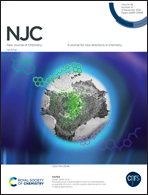Theoretical study on the structures, electronic properties, and aromaticity of thia[4]circulenes†
Abstract
The structures, electronic properties, and aromaticity of a series of thia[4]circulenes are predicted using quantum chemical calculations. All the thia[4]circulenes studied adopt bowl-shaped geometries which become deeper when the number of thiophene rings is increased. At a local minimum geometry of the singlet state, the HOMO–LUMO gap decreases from 4.00 eV to 1.74 eV when the number of fused thiophene rings is increased. This is attributed to a remarkable decrease of the LUMO energy because of the orbital interaction between the distorted thiophene rings. Monothia[4]circulene, dithia[4]circulenes, and trithia[4]circulene are predicted to have a ground singlet state, yet the energy gap between the lowest singlet and triplet states tends to decrease when the number of thiophene rings is increased. In the case of tetrathia[4]circulene, the energies of the lowest singlet and triplet states are close, and theoretical prediction of the ground spin state is not conclusive. The local aromaticity of thia[4]circulenes is discussed based on structural, electronic, and magnetic criteria. The fused benzene rings show weak or almost negligible aromatic character. On the other hand, the fused thiophene rings exhibit non-aromatic or even weak anti-aromatic character. The central four-membered rings show non-aromatic [4]radialene character. Finally, we address the geometries, electronic properties, and aromaticity of tetrathia[4]circulene in the open-shell states. The present results demonstrate that increased structural distortion in [4]circulene through the substitution of the benzene rings with thiophene rings has a strong impact on its structure, electronic properties, and aromaticity.
![Graphical abstract: Theoretical study on the structures, electronic properties, and aromaticity of thia[4]circulenes](/en/Image/Get?imageInfo.ImageType=GA&imageInfo.ImageIdentifier.ManuscriptID=D2NJ04359A&imageInfo.ImageIdentifier.Year=2022)


 Please wait while we load your content...
Please wait while we load your content...